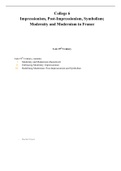College 6
Impressionism, Post-Impressionism, Symbolism;
Modernity and Modernism in France
Late 19th Century
Late 19th Century, contents;
I. Modernity and Modernism (theoretical)
II. Embracing Modernity: Impressionism
III. Redefining Modernism: Post-Impressionism and Symbolism
- Rachel Esner
, Modernisme vs. Moderniteit.
Ja, modernisme is de kunststroming, ongeveer vanaf de impressionisten tot.. nouja, het post-
modernisme. Moderniteit is een veel groter begrip: het gaat hoe de hele samenleving
verandert onder invloed van 'de moderne tijd'. In de moderne tijd gaat alles sneller, er is
industrialisatie, er komen spoorwegen, urbanisatie, en nieuwe materialen zoals ijzer, er komt
kapitalisme, kolonialisme et cetera.
Kortom:
moderniteit = sociologisch/economisch/politiek verschijnsel
modernisme = kunststroming
Oh en wel belangrijk: modernisme is altijd een reactie op de moderniteit! Of het nu een
tegenreactie of nou een omarming ervan is, het is er inherent aan verbonden. Modernisme die
kan de modernity/moderniteit omarmen of bekritiseren.
, I. Modernity and Modernism (theoretical)
1852 – 1870: The Second French Empire
o 1848 revolution → France became a democratic republic briefly.
o 1851 coup and dictatorship of Napoleon III (Imperial Bonapartist regime of Napoleon III.)
o In 19th Century there were many developments in infrastructure, banking, capitalism,
railways, new industries, technology: everything was developing, and all pushed forward
by the Napoleonic government, though at the same time the government being
conservative.
o Because the MC-people were getting richer, more technology and more goods being
produced: => we can say this is the period of the beginning of consumer-culture.
1852 – 1870: The Second French Empire
o Dictatorship of Napoleon III: (held coup in 1851)
o Belief in industry, science and technology as engines of progress
o Politically conservative
o Wealth based on banking and speculation
- “Hausmannization” and other infrastructure projects (e.g. railroads)
- Transformation of Paris from medieval city to what we know today
o Birth of consumer culture
- People were becoming richer, also the middle class
- More time for leisure activity
- More goods were produced
This period we can call ‘modernity’
We already talked about this from Baudelaire’s point of view. But modernity as a period:
Characteristics of this modernity-period: What is modernity?
• New Industrialization; steam engine, mass production,
• Super important especially for impressionism: Urbanization. You have people moving to
cities, and all new interactions between classes and peasants with city people and
immigrants; mix. Gingantic moment of growth.
• Capitalism: important characteristic of modernity: this has now become the established
social and economical based on massproduction, labour, consumerism, but also of
alienism of all parts of life.
• People becoming wealthier -> able to consume: leisure and consumerism
• New materials and technologies; most new things were made with cast iron, but also:
photography, electricity, phone -all can be associated with modernity
• paint in tubes (mid 19th ), which gave freedom to take paint and work outside,





